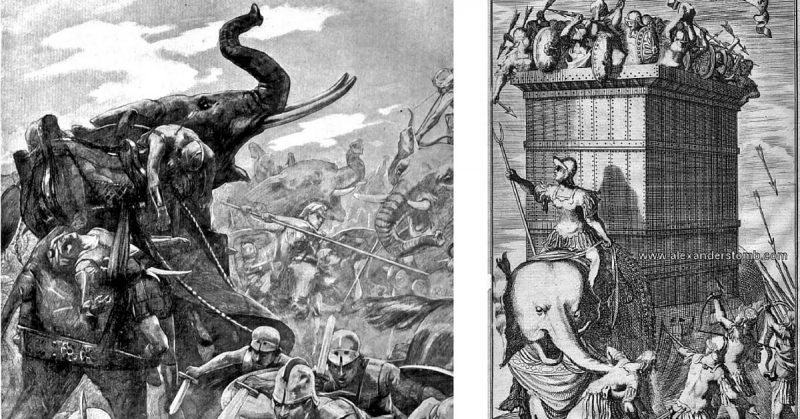Alexander the Great’s expansive politics led him to the eastern bank of the river Hydaspes. This river was in Pauravas, an ancient kingdom in the northwest Indian subcontinent, under the rule of King Porus.
The Macedonian conqueror and the King of Pauravas fought each other in the Battle of the Hydaspes river in an epic clash between two cultures. Alexander’s victory has lived on in history as one of the most brilliant examples of his tactical genius, but it also remained the most costly battle his army ever fought.
His victory at Hydaspes led to increased Greek cultural, political and economic influence in Indian lands, and these influences have continued to echo down the centuries.
Forward to the East
Alexander the Great of Macedonia, having utterly conquered the Achaemenid Persian Empire, now was about to fight his way through the lands of Punjab. The courageous leader led his army on a victorious march deep into the Indian subcontinent. His first target was the Aornos fortress, for it was of deep significance to his ancestry. Commanding a small force he besieged the fortress in 326 BC, successfully gaining control over it. He had outdone Heracles, who had been unable to capture it. A year later, having rejoined his main army, he passed through the mountainous Khyber Pass in the Spin Ghar Mountain range.
United with his complete army once again, Alexander continued his march fighting his way through Punjab. The estimates of Alexander’s numbers vary, but he certainly had a force of infantry at least 40,000 strong, and possibly as many as 7000 cavalry at his command.
Ambhi, the king of Takshalisa, knew Alexander would soon reach his kingdom and hurried to ally with the Alexandrian Emperor . He sent an ambassador to Alexander, along with gifts of gold, silver, Indian war elephants and a small cavalry unit. After he had sworn allegiance to Alexander he was rewarded and his own gifts were returned. Alexander and Ambhi allied against the enemy of the Takshalisa – King Porus of Paurava. Ambhi and 5000 of his men continued with Alexander since he was promised a chance to fight with Porus.
Maneuvers of the armies
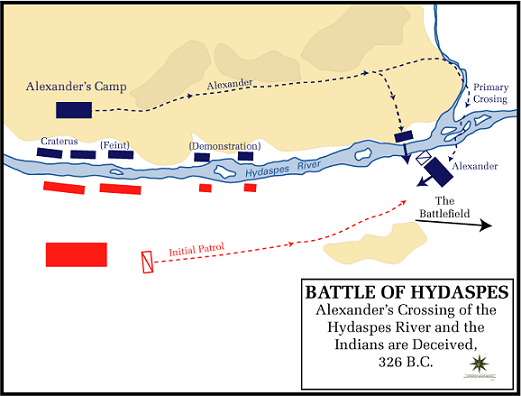
Moving eastwards, Alexander made a camp near the city of Jhelum, on the right bank of the river, while the enemy was lurking on the left one, expecting Alexander to cross. Porus hoped Alexander would make an attempt to get on his side of the river, launching an all-out attack, an action Porus knew would be devastating for his enemy. At that time of the year, the water ran deep and would be sure to drown any who dared to attempt the crossing. Alexander was not easy to fool and he knew what dangers the crossing hid. He ordered a small mounted force to inspect the river in both directions, and at last found a suitable place to cross just 27km away from his camp.
Alexander’s general Craterus was left in the camp with the larger part of the army and very specific orders. He was to either strike Porus if he attacked Alexander with his entire army or guard the base if the Indian king was not with all his men. The Macedonian conqueror went upstream to the crossing point, taking with him a small but strong force of 10,000 men, both mounted and on foot.
Porus, unaware that Alexander had found a place to cross the river and had already left the camp, was busy keeping an eye on Craterus. Alexander’s General repeatedly deceived the Indian king, making it look as if he was about to make an attempt to cross to the other bank. Porus soon began to feel secure that no one was going to surprise him and his guard was lowered, but just to be sure he sent his son patrolling with a small force, convinced that anyone who tried to pass would be immediately spotted and executed.
At that time, Alexander had already crossed the river and the young prince, also named Porus, was unfortunate enough to meet the Macedonian.
Swiftly Alexander and his men routed the troops under the command of the prince and killed him too. Soon enough King Porus was alarmed to find that Alexander had succeeded in crossing the river and that he had also taken the life of his son. Infuriated, he wanted to rain down terror and hell on Alexander and mobilized his army, leaving a small force to deal with general Craterus if he dared to cross. Porus’ force was huge. He had almost 50,000 infantry, several thousand cavalry, a couple of hundred mighty war elephants and about a thousand chariots. Though different sources again give different estimates of the numbers involved, we can be sure that Porus’ army outnumbered Alexander’s by a good margin, maybe as much as five-to-one.
Battle of the Hydaspes
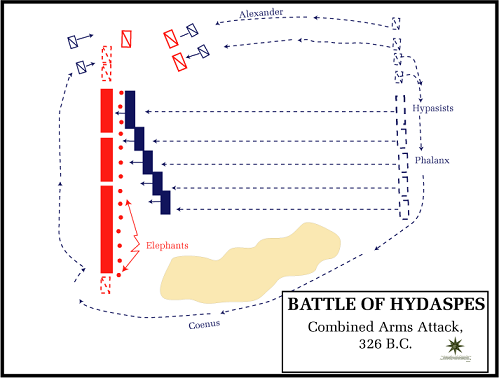
Once King Porus met the army of Alexander the Great he ordered the attack. Alexander immediately ordered his horse archers to darken the sky with arrows. The volley rained down mercilessly on the Indian army’s left wing .
Even then king Porus’ army was tirelessly moving forward. He had divided his army into two cavalry wings and protected his center with war elephants, pushed together with the infantry. Alexander’s phalanx attacked the center of the Indian army, taking down the war elephants by targeting their eyes with long and bitter spears.
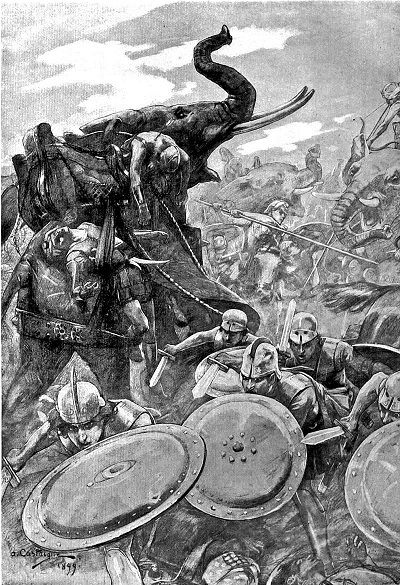
As the left wing of the Indians grew weaker, Alexander charged in, and the cavalry on the right rushed to help their brothers, breaking their lines. At this moment to their surprise, Alexander’s general Coenus ripped into the flank of the enemy with his cavalry. This unexpected attack from the rear confused the Indians even more and they failed to form a defense, with their lines in complete disarray. Being attacked on both sides and incapable of reorganizing, they were completely routed and what was left of them made a desperate attempt to unite with the center, seeking cover behind the war elephants.
At this point in the battle, the war elephants were out of control and running wild, some impaled from the spears of the Macedonians’ phalanx, others crushing everything in their path, flinging men across the battlefield with their tusks. The entire Indian army was now completely in chaos, and soon enough the elephants running completely wild, left the battle, trampling everyone on their way. Porus’ men were left alone and circled by the enemy. Alexander’s men locked their shields into a wall trapping their panicked enemy in a huge crush.
Aftermath
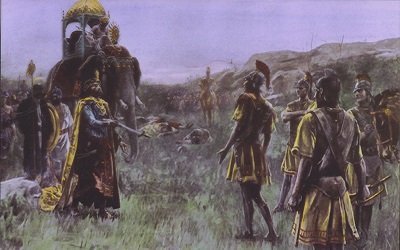
Porus realized he was defeated fled with some few who managed to escape. Ambhi, who was sent to capture him, was almost killed in the pursuit . In the end, Porus was once again in front of Alexander. The Macedonian entrusted the lands he had conquered between the river and the Indus to Ambhi, for his loyal and complete service. Alexander was also greatly impressed by the bravery and skill of King Porus. Instead of taking his life, the Macedonian conqueror left Porus to rule over the Hydaspes as his loyal vassal and a king. Alexander the Great founded two cities one on each side of the river, to honor his victory: Nicaea and – in memory of his steed that died soon after – Bocephalia.
After his great victory, Alexander had to quickly finish his expansion to the East, for he had to return to his homeland. He was also told by General Coenus that the army morale was dropping as quickly as their size. They were a long way from home, tired and suffering from the long years of warfare. He continued down the river in order to reach the sea, capturing every city and settlement on his way, and sending a powerful signal of his undaunted power to the already subdued kingdoms.
